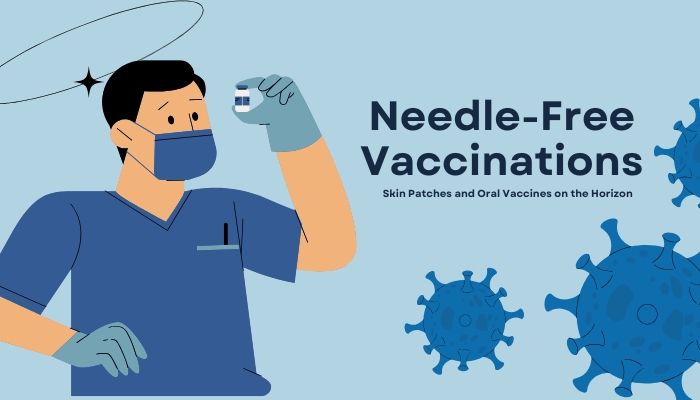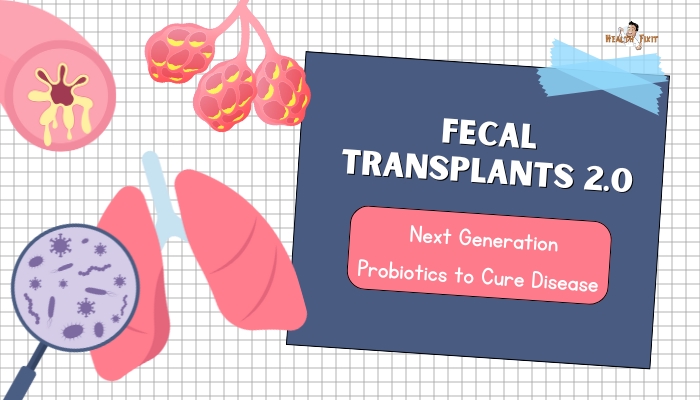Introduction
Many people experience anxiety and discomfort with injections, and delivering vaccines through needles typically requires trained healthcare providers and stringent cold-chain logistics.
Researchers are addressing these challenges by developing needle-free vaccination methods.
These alternatives aim to simplify immunization campaigns, boost coverage, and reduce pain or needle-related risks.
Technologies range from microneedle patches that painlessly deliver vaccine into the skin to oral formulations that harness the gastrointestinal immune system.
If these approaches mature, we may soon see mass vaccination without the stress of needles.
This article explores different needle-free methods, their mechanisms, developmental progress, and potential to transform public health.
From microneedles to inhalable vaccines, these systems could reshape how society approaches routine immunizations, pandemic responses, and global disease control.
Why Move Beyond Needles?
Overcoming Phobia and Discomfort
Many individuals, especially children, fear needles, potentially deterring vaccination compliance. A painless or needle-free method encourages participation, critical to widespread immunization efforts.
Reducing Safety Risks
- Accidental Needlesticks: Health workers face infection risk from contaminated needles.
- Waste Management: Disposing of used syringes safely is costly and logistically challenging. Needle-free devices simplify disposal and reduce the risk of re-use.
Easier Logistics
Some novel technologies do not require highly trained staff or complex equipment, streamlining mass vaccination and remote outreach. Certain patches or oral capsules might also ease cold-chain requirements if formulated for stability at higher temperatures.
Enhanced Efficacy
Alternatives like skin patches can target potent immune sites, such as specialized skin cells (Langerhans cells), which may yield robust immune responses with smaller doses. Oral formulations can induce mucosal immunity, a key barrier against enteric diseases.
Microneedle Patches
Design and Mechanism
Microneedle patches typically feature an array of tiny needles—often less than a millimeter in length—coated or filled with vaccine. When pressed onto the skin, they painlessly penetrate the outer layers, delivering the antigen to immune cells in the dermis.
- Solid Microneedles: Coated with vaccine or dissolvable tips that release the antigen upon insertion.
- Hollow Microneedles: Deliver liquid vaccine through micro-channels.
Benefits
- Minimal Pain: The needles are too short to reach deep nerves, so most users only feel slight pressure.
- Self-Administration: Some patches can be applied by individuals without specialized training.
- Dose Sparing: Targeting immune-rich skin layers may use lower doses to achieve comparable immunity.
- Low Sharps Waste: Microneedles can dissolve or be safe upon removal.
Ongoing Trials
Microneedle patches have progressed through various phases of testing for influenza, measles, polio, and COVID-19. Early results are promising, showing immunogenicity similar to or better than traditional shots. Researchers refine patch designs, focusing on consistent vaccine release and safe disposal.
Jet Injectors and Powder Delivery
Jet Injectors
Jet injectors (needle-free injectors) use high-pressure fluid streams to penetrate the skin:
- Mechanism: A spring or gas-driven piston forces vaccine liquid through a tiny orifice, creating a narrow, high-speed jet.
- Advantages: Eliminates needles, can deliver quickly in mass settings, historically used in smallpox eradication campaigns.
- Drawbacks: Potential for cross-contamination if not properly cleaned, may cause local bruising.
Modern jet injectors incorporate disposable cartridges and advanced pressure controls to minimize contamination risks and improve user comfort. They see use for flu shots and some routine pediatric vaccines in certain regions.
Powder or Dry Injectors
In powder injection, the vaccine is formulated as micro-particles. A high-pressure gas flow blasts these particles into the superficial skin layer:
- Advantages: Thermally stable powder can ease cold-chain demands; less disposal waste.
- Challenges: Achieving consistent particle size, ensuring uniform penetration, and controlling pain or local irritation.
Though not yet mainstream, powder-based devices could provide stable, needle-free vaccinations for large campaigns.
Oral Vaccines
Capsules, Tablets, or Liquid Drops
Oral vaccines represent a simpler route: swallowing a pill or solution. Notable examples include the oral polio vaccine, which has aided in near-eradication efforts worldwide. But for many pathogens, delivering protective antigens orally is complex due to stomach acid and digestive enzymes.
New strategies combine protective coatings or microencapsulation to preserve antigens until they reach the gut’s immune tissue. The goal is to trigger strong mucosal and systemic immunity without needing an injection.
Dissolvable Films or Strips
Another approach is a thin oral film that dissolves under the tongue or inside the cheek, allowing sublingual or buccal absorption. This bypasses harsh gastric conditions and can stimulate local mucosal immunity.
Emerging Targets
- Enteric Diseases: Cholera or rotavirus are prime for oral vaccines due to their gastrointestinal infection site.
- COVID-19, Influenza: Trials explore tablets or nasal sprays. The convenience might boost compliance, especially if annual boosters are needed.
Other Experimental Routes
Inhalable Vaccines
Delivering vaccines via aerosols to the lungs has tested well for influenza (e.g., FluMist nasal spray). Inhalable forms for TB or measles could simplify mass immunization. However, production, distribution, and user acceptance (e.g., proper inhalation technique) require further refinement.
Transdermal Patches (No Needles)
Some patches use electroporation or chemical enhancers to push antigens through intact skin. However, the mild discomfort from microcurrent or chemical irritants can be an issue, and controlling antigen dosage remains challenging. These methods remain largely experimental.
Key Benefits and Challenges
Benefits
- Less Pain, Less Fear: Encourages vaccine uptake.
- Easier Administration: Some methods enable self-application.
- Reduced Need for Professional Staff: Could scale immunization in low-resource settings.
- Potential Dose Sparing: Some methods deliver antigen directly to immune-rich tissues.
- Lower Sharps Waste: Decreases disposal costs and safety hazards.
Challenges
- Ensuring Consistent Dose: Variation in patch adhesion, oral bioavailability, or inhalation technique can lead to unpredictable antigen delivery.
- Vaccine Stability: Some novel forms still require refrigeration. Achieving stable formulations for microneedles or oral capsules is non-trivial.
- Regulatory Hurdles: Each new device or route must pass rigorous clinical evaluations.
- Manufacturing Scale: Setting up production lines for patches or specialized injectors might be costly initially.
- Public Acceptance: People may be cautious about new technology or worry about efficacy compared to proven needle injections.
Current Status in Clinical Use
Influenza Microneedle Patches
Some pilot human studies show that microneedle patches for flu are immunogenic and well-tolerated. Larger trials must confirm real-world efficacy, but the technology is on track for possible commercial rollout.
Oral Polio Vaccine (OPV)
Already a massive success story. Though not purely “needle-free technology,” OPV demonstrates the potential of oral immunization for widespread coverage—helping nearly eradicate polio. Future improvements in formulation might reduce rare cases of vaccine-derived polio.
Intradermal Jet Injectors
A few devices licensed for influenza or other adult vaccines use high-pressure jets for shallow injection. They deliver smaller vaccine volumes with strong immunological effect. Their adoption remains limited, but data is promising.
Future Outlook
Combining with Next-Gen Vaccines
Many new vaccines (like mRNA-based) are tested with needle-syringe injection. However, integrating them with microneedles or other routes could further reduce barriers. For example, mRNA-based microneedle patches are in preclinical studies, aiming for a more comfortable, self-administered approach.
Pandemic Preparedness
In a future pandemic, quick coverage is vital. Needle-free technologies might accelerate mass immunization without exhausting professional resources or producing mountains of sharps waste. Patches or pills that can be mailed to households might limit clinic visits, especially under lockdown conditions.
Personalized or At-Home Delivery
Where feasible, wearable patches or oral tablets for booster shots could become part of standard immunization schedules. Telemedicine oversight might track compliance, with digital reminders prompting individuals to apply patches at scheduled intervals.
Practical Tips for Patients and Providers
- Stay Informed: Needle-free vaccines are still emerging. Check official guidelines or trial announcements if you’re needle-phobic or seeking alternative approaches.
- Technique Matters: For patches or jet injectors, correct application or usage is essential. Follow instructions closely to ensure proper immunization.
- Consult Healthcare Professionals: Existing needle-free devices might not be widely available or covered by insurance. Discuss options, pros, and cons with your provider.
- Be Open to Trials: Many microneedle or oral vaccine candidates recruit volunteers for clinical studies—an opportunity to help shape future immunization methods.
Conclusion
Needle-free vaccine delivery represents a transformative step in modern immunization. Microneedle patches, jet injectors, oral vaccines, and inhalable systems each offer unique advantages—reduced fear, simpler logistics, and potential for dose sparing—aimed at broadening vaccine access and acceptance.
Though each technology faces hurdles regarding dose consistency, manufacturing scale, and regulatory approval, progress is undeniable.
Pilot studies in humans demonstrate real efficacy and user satisfaction, fueling ongoing research and commercial interest.
As these methods mature, global vaccination efforts could be streamlined, especially in large campaigns or resource-limited settings.
Patients might soon have the option of receiving vaccines through painless skin patches, quick oral capsules, or advanced jet sprays, sparing them the anxiety and inconvenience of traditional needles.
Ultimately, these needle-free innovations could bolster global health, ensuring broader coverage and resilience against emerging infectious diseases.
References
- Prausnitz MR, Mikszta JA, Cormier M, Andrianov AK. Microneedle-based vaccines. Curr Top Microbiol Immunol. 2009;333:369–393.
- Norman JJ, Arya JM, McClain MA, et al. Microneedle patches: usability and acceptability for self-vaccination against influenza. Vaccine. 2014;32(16):1856–1862.
- Nguyen TT, Park JH, Jung H. Skin immunization: micropatch technology for vaccine delivery. Expert Opin Drug Deliv. 2018;15(2):229–243.
- Hirobe S, Okada N, Nakagawa S. The development and clinical evaluation of a micropatch-based influenza vaccine. Vaccine. 2021;39(1):7–13.
- Chen X, Kask AS, Vasconcelos A, et al. Skin vaccination using vaccine-loaded dissolvable microneedles: the peanuts and the haystack. Vaccine. 2012;30(3):520–525.
- Giersing BK, Modjarrad K, Kaslow DC. Tailoring influenza vaccines—changing the needle. Lancet Infect Dis. 2017;17(11):1126–1127.
- Tacket CO, Cohen MB, Wasserman SS, et al. Phase 3 study of high- vs low-dose polio vaccine. J Infect Dis. 2020;221(5):889–895.
- Giudice EL, Campbell JD. Needle-free vaccine delivery. Adv Drug Deliv Rev. 2006;58(1):68–89.
- Arnou R, Icardi G, De Decker M, Ambrozaitis A, Kazek MP, Weber F. Intradermal influenza vaccine: promising results. Lancet Infect Dis. 2018;18(9):937–938.
- Gutierrez AH, et al. A needle-free microneedle vaccine approach for next-generation mRNA vaccines. Biomedicines. 2022;10(7):1609.




